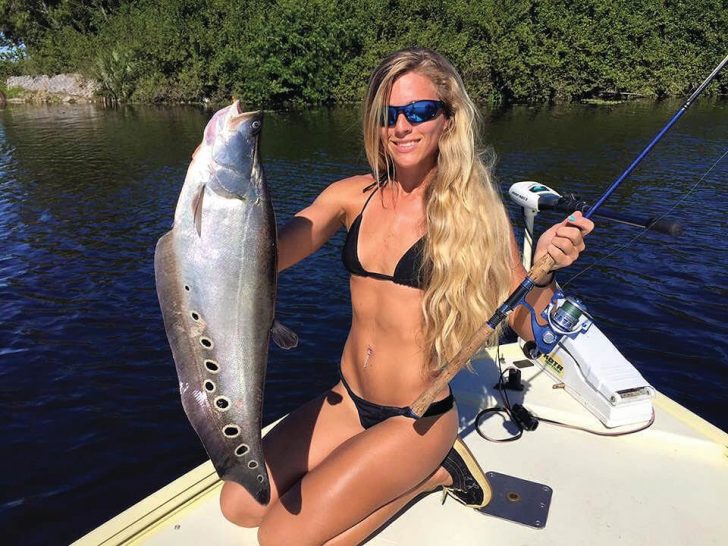
The freshwater system in South Florida is home to more than 20 permanent populations of non-native fish, according to the Florida Fish and Wildlife Conservation Commission (FWC). These warm-water lakes, ponds, and canals are welcoming to species from all over the world, and whether populations were the result of being released, escape, or intentional introduction, they are here to stay.
Darcie Arahill, also known as Darcizzle Offshore, knows her way around these canal systems, where largemouths grow large and a host of exotic fish thrive. She has a particular enthusiasm for Delray Beach, Florida.’s Lake Ida, which is a small water body in a system of freshwater lakes and canals along Florida’s southern Atlantic coast. She enjoys the excellent bass fishing, but even more appealing are the exotics that happen to be fantastic gamefish. The following odd-balls are some of Darcie’s favorites from a fishery unlike any other on the continent.
Sunshine Bass:
These hard-fighting fish are produced and stocked by the FWC to control shad populations. They are a hybrid cross between striped bass and white bass without the capability to reproduce. State agencies across the country stock their versions of sunshine bass for management and as sportfish. Their regional variations are called hybrids, wipers, whiterock, and palmetto bass.
Sunshine bass can offer the fight and some of the size of a striped bass, while displaying the aggressive feeding behavior and warm-water tolerance of white bass. Although the current strain being produced might not be capable of achieving the size of the more than 16-pound state record, Darcie said they catch plenty of 5 to 6 pounders.
Sunshine bass will take artificials like bucktails and swimbaits, but Darcie said you’re better off fishing live American shad or shiners on a Carolina rig.
Clown Knife Fish:
Lake Ida, its northern sister Lake Osborne, and their canals are the only places in North America where anglers can pursue clown knife fish. These aquarium escapees have become a greatly desired gamefish for those in the know. They are a flat, silvery fish with a snake-like tail. They can swim powerfully either forward or backward, which produces a unique fight.
Darcie said these natives to tropical Asia jump like tarpon, and they have been recorded up to 10 pounds in Florida. A clown knife fish might eat a swimbait, but Darcie said live bait is best. Live shad or shiners are a good bet.
Peacock Bass:
A native to the Amazon River Basin, the butterfly peacock bass has generated many a grand fishing adventure to South America. These gorgeous fish were introduced to Florida by the FWC in the 1980s to control invasive forage species. Anglers are glad to have them.
Sensitivity to cool water keeps peacock bass in check. They thrive only in southeast Florida and grow to their largest size in the canals around Miami-Dade and Broward counties, where a 12-pounder was reportedly caught as well as the documented 9.08-pound state record.
“They’re very aggressive, and they’re a beautiful fish to catch,” said Darcie. “They fight twice as hard as a largemouth.”
Butterfly peacocks have spread as far north as West Palm Beach, but cold snaps knock them back every few winters. They will hammer topwater baits and moving baits like crankbaits, wakebaits, and swim jigs.
Check out Darcie’s YouTube channel Darcizzle Offshore at www.youtube.com/user/DarcizzleOffshore.